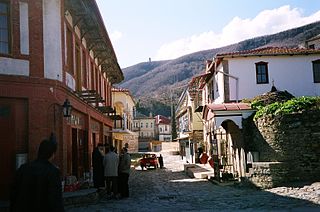Related Research Articles

Mount Athos is a mountain in the distal part of the eponymous Athos peninsula and site of an important centre of Eastern Orthodox monasticism in northeastern Greece. The mountain along with the respective part of the peninsula have been governed as the monastic community of Mount Athos, an autonomous region within the Hellenic Republic, ecclesiastically under the direct jurisdiction of the Ecumenical Patriarch of Constantinople, while the remainder of the peninsula forms part of the Aristotelis municipality. Mount Athos has been inhabited since ancient times and is known for its long Christian presence and historical monastic traditions, which date back to at least 800 CE during the Byzantine era. Because of its long history of religious importance, the well-preserved agrarian architecture within the monasteries, and the preservation of the flora and fauna around the mountain, Mount Athos was inscribed on the UNESCO World Heritage List in 1988.
The Philokalia is "a collection of texts written between the 4th and 15th centuries by spiritual masters" of the mystical hesychast tradition of the Eastern Orthodox Church. They were originally written for the guidance and instruction of monks in "the practice of the contemplative life". The collection was compiled in the 18th century by Nicodemus the Hagiorite and Macarius of Corinth based on the codices 472, 605, 476, 628 and 629 from the library of the monastery of Vatopedi, Mount Athos.

Simonopetra Monastery, also Monastery of Simonos Petra, is an Eastern Orthodox monastery in the monastic state of Mount Athos in Greece. Simonopetra ranks thirteenth in the hierarchy of the Athonite monasteries.

The Monastery of Iviron is an Eastern Orthodox monastery in the monastic community of Mount Athos in northern Greece.

Dionysiou Monastery is an Eastern Orthodox monastery at the monastic state of Mount Athos in Greece in southwest part of Athos peninsula. The monastery ranks fifth in the hierarchy of the Athonite monasteries. It is one of the twenty self-governing monasteries in Athos, and it was dedicated to John the Baptist.

Xeropotamou monastery is an Eastern Orthodox monastery at the monastic state of Mount Athos in Greece, in the middle side of peninsula. The monastery ranks eighth in the hierarchy of the Athonite monasteries. It was founded in the 10th century, and is dedicated to the Forty Martyrs of Sebaste.

Karyes is a settlement in Mount Athos of the Athonite monastic community. The 2011 Greek census reported a population of 163 inhabitants. It is the largest settlement in Mount Athos.
The protos is a monastic office at the Eastern Orthodox monastic community of Mount Athos in Greece. The office headquarters are located in Karyes, Mount Athos.
Gerald Eustace Howell Palmer was a United Kingdom author, book translator, and Conservative Party politician. Palmer's work in translating the Philokalia, an Eastern Orthodox spiritual text, is still recognised in modern times with the popularity of that book.
Gregory of Sinai, or in Serbian and Bulgarian Grigorije Sinaita, was a Greek Christian monk and writer from Smyrna. He was instrumental in the emergence of hesychasm on Mount Athos in the early 14th century.

Ouranoupoli is an ancient city and a modern village in Chalcidice. The village is today called Ouranoupoli.

Peter the Athonite is reputed to have been the first hermit to settle upon the Mount Athos.
Maximos of Kafsokalyvia or Maximos Kausokalybis, also known as St. Maximos the Hut Burner, was a hesychast monk who lived on Mount Athos in Greece. Some of Maximos' writings on prayer and ascetism are included in the Philokalia.

The Skete of St Anne is a dependent idiorrhythmic (hermitage-style) skete, a monastic community attached to the more formalised Great Lavra Monastery in Mount Athos, Greece.

The monastic community of Mount Athos is an Eastern Orthodox community of monks in Greece, enjoying the status of an autonomous region holding the combined rights of a decentralized administration, a region and a municipality, with its territory encompassing the distal part of the Athos peninsula including Mount Athos, while the bordering proximal part of the peninsula belongs to the regular Aristotelis community in Central Macedonia.
Saint Acacius or Akakios the Younger, also known as Akakios the New of Kafsokalyvia was a Greek Orthodox Christian monk and ascetic who lived on Mount Athos. His feast day is celebrated by the Eastern Orthodox Church on April 12.
Mount Athos has an extensive network of footpaths, many of which date back to the Byzantine period. These paths are typically trails designed for human foot traffic and mules, and are not wide enough for motor vehicles. They connect the various monasteries, sketes, cells, kathismas, and hermitages on the peninsula to each other.

Kafsokalyvia is a settlement and idiorrhythmic skete in Mount Athos. It is located at the southern edge of the Athos peninsula. Kafsokalyvia is named after Maximos Kausokalybites, a 14th-century Christian hermit.

The Protaton, also known as the Dormition of the Theotokos Church, is the main church of Karyes, Mount Athos. It also serves as the ecclesiastical seat of the Protos, or the primate of the monastic community of Mount Athos. It was founded in the early 10th century AD, prior to the completion of the Great Lavra in 963.

The Desert of Mount Athos is a geographical area of Mount Athos that corresponds to the southern slopes of Mount Athos. Located along the southernmost coast of the Athos peninsula, it stretches roughly from Katounakia in the west to Vigla in the east. The Desert of Mount Athos has been a center of Christian asceticism and hesychasm for over 1,000 years.
References
- 1 2 3 "Graham Speake". deniseharveypublisher.gr.
- ↑ "Mount Athos - Graham Speake, Kallistos Ware". azbyka.ru.
- ↑ "Officers – FOMA".
- ↑ "Marriages". The Times. 24 September 1971. p. 14.